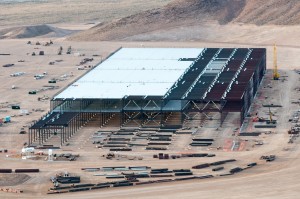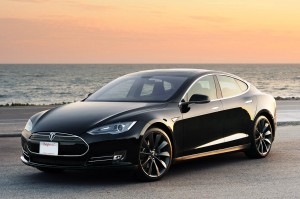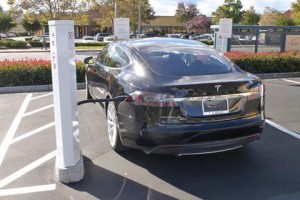The Reno Gazette-Journal checks in for an update on the battery megafactory, and the results are mixed to date:
The Tesla-Panasonic battery gigafactory is falling far short of the economic impact projections on jobs and capital investment used to persuade lawmakers to approve a record-breaking tax incentive package for the project, according to an analysis by the Reno Gazette-Journal.
According to the review of available public documents, the project has generated just a fraction of the jobs, payroll and capital investment projected for the first year in a study commissioned by the Governor’s Office of Economic Development during the 2014 special session.
The numbers also have not kept up with the more refined projections used by Tesla in its application for incentives that will allow the company to operate tax free for a decade and with substantially reduced taxes for a second decade.
Nevada leaders don’t sound worried because the tax benefits go away if certain benchmarks aren’t met. And the factory is already starting to produce home batteries for stationary energy storage.
At this point, it’s probably not a cause for concern, although it may be an indication that construction isn’t where Tesla hoped to be at this point.
Long term, the real value in the Gigafactory for the Reno area is not in construction jobs, but in the higher-paid engineering and other high-skilled jobs that will be located on-site, plus all the supply and service industries that will spring up as a result nearby.
At least Nevada leaders hope that’s the case, given the tax breaks they gave Tesla to lure them there in the first place.
Happy 2016! With the new year here, I wanted to reflect on some of the big environmental accomplishments of 2015. Here are my top three best pieces of news on climate change:
3. Paris Climate Agreement: Sure, it was mostly political theater, with a non-enforceable international agreement that could be undermined as soon as next year by a Republican U.S. president. But it was necessary theater. No international action can happen without it, and it’s sets the political foundation for domestic action on carbon reduction in countries and states all over the world. It was also an example of how China’s new commitment to reducing greenhouse gas emissions has changed the politics of climate change.
2. U.S. and California’s Continued Commitment to Solar: Solar PV has made huge gains in terms of efficiency and price competitiveness over the past five years. But its progress could have been badly undermined had the U.S. federal government not continued the policy of giving a 30% investment tax credit for solar PV (and other renewable energy) purchases. Meanwhile, California, solar PV’s largest market, could have dramatically killed demand by gutting the rate incentives for homeowners to go solar. Fortunately, both governments backed away from the brink. The new federal budget continues the investment tax credit, while California’s energy regulator appears committed to keeping the current rate incentives intact (although Severin Bornstein offers a compelling case for an alternative approach). The resulting demand will ensure that solar PV is here to stay and will only become more cost-competitive with fossil-fuel sources of power going forward.
1. Tesla’s Increasing Sales Rate: It was a down year for EVs, with cheap gas prices and not a lot of new models to choose from. Tesla vehicles may still be a plaything for the wealthy, but the company’s dominance at the top of the EV market will eventually lead to an energy revolution for all — and that’s no understatement. Encouragingly, Tesla sales were up 60% in 2015 over 2014, to over 50,000 units, blowing by Nissan LEAF’s sales of about 18,000. And with the new all-electric SUV Model X ramping up, we’re starting to see Tesla’s long-range plan take shape: start at the top, and then use the sales to fund a mass-market EV. When that model comes out, we’ll finally get the transition to a low-carbon economy we need: cheap battery electric transportation, coupled with mass energy storage from the batteries, both in and out of the vehicles.
We’ll see what 2016 brings, but for now, we certainly have something to celebrate as 2015 hits the books.
The company is at it again. With a software update sent over the air to anyone who bought a Tesla since the fall of 2014 and is willing to pay $2500, the vehicles will now be able to do the following:
Autopilot allows Model S to steer within a lane, change lanes with the simple tap of a turn signal, and manage speed by using active, traffic-aware cruise control. Digital control of motors, brakes, and steering helps avoid collisions from the front and sides, as well as preventing the car from wandering off the road. Your car can also scan for a parking space, alert you when one is available, and parallel park on command.
Musk keeps making big promises, but this latest rollout is evidence that he might be able to actually keep them. In particular, he recently pledged that the company will be making 745-mile range batteries in completely autonomous vehicles by 2020.
What would this mean for the environment? To quote Trump, HUGE. On the EV side, it means an accelerated move from petroleum fuels to electricity in battery electric vehicles. It means more mobile battery storage that can provide grid services like smart charging (soaking up surplus solar power, for example) and possibly vehicle-to-grid power (sending electricity back to the grid from the car battery when it’s needed). And it means cheaper batteries more generally that can be used for stand-alone energy storage.
But it also means that a revolution in passenger vehicle travel could be around the corner. With autonomous vehicles, cars can drive more efficiently and therefore reduce tailpipe emissions, and they potentially could be more easily rented on-demand, meaning reduced auto ownership and the associated need for real estate devoted to parking (downtown parking garages and home garages, most prominently).
So even if you’re not a technophile or car person, there’s plenty of reason to be optimistic with this latest development.
Tesla made headlines this week finally unveiling the new Model X SUV. The car looks amazing as expected, but Tesla is only shipping a select version to work out the kinks among it’s well-heeled customers. It won’t be available to the greater public for another year.
Meanwhile, the San Francisco Chronicle compares Tesla’s approach to Google, with its goofy-looking self-driving vehicle:
Google co-founder Sergey Brin sees a future in which self-driving technology takes several forms. That future, he said, should still have room for people who enjoy taking the wheel on a wide-open, twisty strip of asphalt. People like Brin.
“I don’t think we’re going to see ‘no human drivers’ any time soon,” he said this week at an open house for the company’s autonomous car program. “I love the idea of being out on an open road that’s curvy and fun. But in practice, that’s maybe 1 percent of my experience. Mostly, it’s stop-and-go traffic. It’s not nearly that pleasant. And then I’m hunting for parking.”
Google has spent six years on self-driving cars. Its test vehicles have logged 1.2 million miles of autonomous driving, adding an additional 10,000 to 15,000 every week. While impressive, the results still feel like a work in progress.
For its part, Tesla fully envisions self-driving capabilities for its vehicles, even equipping with them with sensors for when the software becomes widely available.
We’re still years away, but to my mind, the future of cars is becoming clearer: they will be electric, self-driving, and rented on demand by most drivers.
David Roberts at Vox.com makes the case for this utopia, describing the huge environmental benefits. Current cars are over-engineered, as is our urban space, for bulky cars built to withstand impacts and for long road trips that we rarely if ever take.
So the future will involve right-sizing cars that can be delivered autonomously to your home (maybe you need an SUV, maybe you need an electric bike). The vehicles will have a smaller environmental footprint (literally, in some cases), and homes won’t need to waste space on garages and other parking spaces. Towns won’t need big parking lots, at least within the downtown.
The environmental upside is big. The battery-powered cars will be distributed storage for the grid, and we won’t need as much auto-oriented infrastructure. Of course, we still want pedestrian friendly, transit-oriented communities. But we shouldn’t ignore the larger technology trends that are shaping the future while we try to plan for it.
Well, this was an entertaining read. After Tesla was once again awarded the highest score ever by Consumer Reports for its Model S P85D, the conservative-leaning Wall Street Journal tried to bash one of the best economic success stories of California and the Obama Administration. But Daily Kos dissected the attacks one-by-one in an expletive-laced diatribe. Here’s an excerpt:
Let’s go to the Wall Street Journal’s op-ed pages, where peak conservative is in action:
Consumer Reports Spends Its Juice, Badly
The product reviewer raves that a new Tesla ‘broke’ its rating system, but the real culprit is in the mirror.
Consumer Reports broke its ratings system and is totally like, “Wasn’t me, it was … that guy!”
If, with their own money, Tesla and its customers want to revel in electric cars, that’s wonderful. Nobody should object. But why should taxpayers subsidize their hobby as if some vital public purpose is being served?
Pshaw, clean air and energy independence, that shit is only a HOBBY! Unlike tax breaks to oil companies which serve vital purposes to our friends in the oil biz.
And why should Consumer Reports prostitute itself in its latest review of the Tesla Model S P85D, calling it basically the best car ever, with a higher-than-possible rating of 103?
Yeah, those guys are fucking whores for liking a car that isn’t a Ford Expedition!
Prostitute is not too strong a word. Consumer Reports does not give away its content for free.
Fucking whores, charging for shit. Unlike the Wall Street Journal, which charges for shit, but isn’t a whore.
The reason became instantly apparent to any visitor who found himself waylaid on almost every page by a full-screen pop-up invitation: “Tesla’s innovation shows we don’t have to compromise. Stand with Consumer Reports as we fight for better cars.”
Consumer Reports is advocating for policies that get better cars to consumers, and they cite Tesla’s success in building a great car as proof that we don’t need to surrender to a gas-powered future. Why doesn’t this infuriate normal Americans like it does conservatives?
You can read the whole thing here.
The San Francisco Chronicle reports on the trend so far with the Tesla resale market:
An analysis of used Model S sales finds that while not many have hit the market so far — just 1,600 — they typically command prices well above $50,000. At the same time, they’re attracting buyers who are a little younger, a little less affluent and less likely to live in California than the typical Tesla driver.
“The way we think of the new Model S buyer is a wealthy tech executive living in the Bay Area — that’s the image in pop culture,” said Jessica Caldwell, director of industry analysis for the Edmunds.com auto information service. “If you have a lower price point, you’re going to get a larger, more diverse pool of people.”
Used EVs, including Teslas but also LEAFs and other models, will be cheaper and help to reach a much larger market. But they will also compete with cheaper, better-range vehicles that will be coming on-line in the next few years. Still, it will be hard to beat a cheap 200-mile used Tesla Model S for the foreseeable future.
Barry Ritholz at Bloomberg seems to think that Tesla just put the nail in the long-term coffin of the internal combustion engine:
What Tesla has done with its “Ludicrous mode” upgrade for the Model S is figure out how to put almost all of the power in its system to all four wheels at once without melting its engine-management components.
The Tesla P85D with the complete 90kWh “ludicrous” upgrade costs about $100,000. The upgrade gives it a 0 to 60 mph time of 2.8 seconds. To put that into context, to get that sort of acceleration from a car previously required a Porsche 918 Spyder (0 to 60 in 2.3 seconds) or a Bugatti Veyron (2.6 seconds) or a Koenigsegg One (2.5 seconds). They each cost $1.1 million, $2.9 million and $3.8 million, respectively.
You can save some money by buying a Lamborghini Huracan ($237,250) or the Ferrari 458 Italia ($239,340), but both are slower than the Tesla. That makes the McLaren 570s a relative bargain at $184,900, but it, too, is slower than the Tesla.
The bottom line for Ritholz, who proclaims himself one not to make bold predictions, is that the top-end market will soon fall to Tesla, followed by the rest of the car market:
My guess is that by 2035, if not sooner, the majority of automobiles sold in the U.S. and Europe will no longer be gasoline-powered.
Let’s hope he’s right, because the future of climate stabilization depends on it.
A highly entertaining and informative (and long) read on the history of energy, climate, cars and Tesla by Tim Urban at “Wait But Why.” Elon Musk participated in the drafting of the post. I was particularly struck by this nugget on climate history:
18,000 years ago, global temperatures were about 5ºC lower than the 20th century average. That was enough to put Canada, Scandinavia, and half of England and the US under a half a mile of ice. That’s what 5ºC can do.8
100 million years ago, temperatures were 6-10ºC higher than they are now—and there were palm trees on the poles, no permanent ice anywhere, ocean levels were 200 meters higher, and this kind of shit was happening:
So we’re currently in this not-that-big window we probably should try to stay in:
I recommend reading the whole thing. Happy Friday!
But just not widespread — yet. The Washington Post discusses the small but growing group of people who are going off-grid entirely with the help of batteries for their solar power. And as battery prices decrease, this trend will only grow, in part thanks to Tesla’s big push in this space:
Batteries already help power homes in places where energy grids are spotty, on islands and in developing countries including India and Bangladesh. But they have remained a niche for homeowners in the U.S., even as more and more demanding connections on America’s aging power grid have pushed power outages up 285 percent since 1984.
Tesla, with its corporate star power, has quickly become the home-battery industry’s best-known cheerleader, and its boosterism could give home batteries their best shot at finding acceptance in mainstream America.
Notably, the only people for now who buy batteries for backup power seem to be those who are concerned about blackouts, want new technology, and have the money to afford it. So it will be important for policy makers to encourage these purchases through better electricity rate design that rewards rooftop solar and other battery customers who can store and discharge power when the grid needs it.
Some interesting nuggets from the EV Iron Man. For example, it sounds like the falcon doors on the new all-electric SUV — the Model X — caused the big-time delays on getting the vehicle rolled out:
Getting that right and making sure it works really well and isn’t a gimmick but is a fundamental improvement in utility and aesthetics for the cars, is extremely difficult. There’s a reason other people haven’t done this. And then the second row seats on the Model X are a piece of sculptural beauty. They’re amazing. They’re the nicest second row seats you’ve ever seen in any car, ever. That actually might have been harder than the door. And there are some other things about the X that people don’t know about yet.
Now I’m curious about being a backseat driver in that car. And then Musk discusses the need to hurry up his mass-market EV, the $35,000 Model III that will go 200 miles on a charge but won’t be delivered until 2017 (if we’re lucky):
There are things we could do with the Model III platform that are really adventurous but would put the schedule at risk. So what we’re going to do is have something that’s going to be an amazing car but it won’t be the most adventurous version the Model III to being with. But we will then have the more different version of the Model III, on the Model III platform, following the initial version.
David Baker in the San Francisco Chronicle criticized Musk’s admission here that later models of the III will be better, arguing that it will scare people away from buying the first year’s model. But I disagree. There’s so much pent-up demand for a mass-market EV that Tesla won’t have any difficulty selling this model.
Finally, there’s Tesla’s play to be an energy storage provider: Musk promises to deliver home batteries in about six months, with an unveiling in another month or so.
All in all, lots happening at the company trying to change the world.








